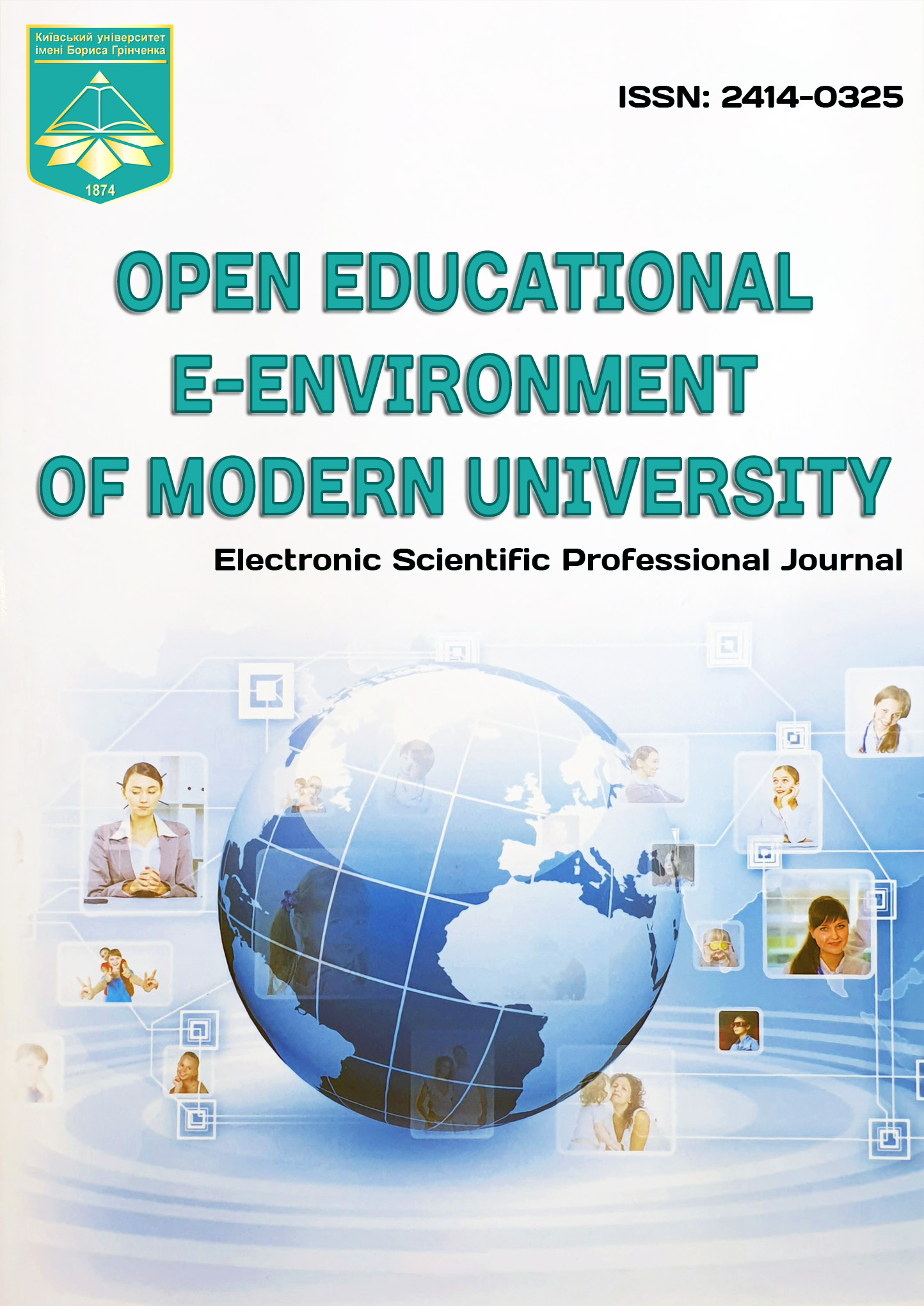THE OPPORTUNITIES OF MOBILE TECHNOLOGIES IN THE PRACTICE OF TEACHING THE UKRAINIAN LANGUAGE AS A FOREIGN LANGUAGE
DOI:
https://doi.org/10.28925/2414-0325.2022.128Keywords:
informatization of education, mobile learning, foreign student, Ukrainian as a foreign language, Medical UniversityAbstract
The article deals with the problem of forming a linguistic personality of foreign medical students. The article highlights the problem of forming the language personality of a foreign medical education seeker in the context of changes in the world and domestic educational systems. The authors analyze the relevance and appropriateness of using mobile technologies in Ukrainian language classes as a foreign language, taking into account the modern development of society, organizational and technological foundations of studying the subject «Ukrainian as a Foreign Language». Considering the trend of transition of users from the operation of desktop personal computers to more mobile portable devices (tablets, smartphones) and based on the problems of organizing the educational process, the assumption of the effectiveness and relevance of mobile technology in teaching Ukrainian as a foreign language. Based on the analysis of the existing definitions of the term "mobile learning" the interpretation was offered, in which mobile devices are the means to achieve didactic objectives. The potential of the use of mobile technologies in education is analysed, as well as the factors that complicate their applications by teachers are given. The domestic experience of using mobile devices for educational purposes is considered. The authors argue that there are many opportunities to transfer information materials to the learner. Options for using mobile learning in Ukrainian as a foreign language classes are shown. The article proposes the use of smartphones when performing practical tasks; target platforms in the study of topics; independent language acquisition; when repeating the material in extracurricular time. The advantages of using mobile devices as convenient tools for accessing cloud services to organize joint activities of students are considered.
Downloads
References
Горбатюк Р. М., Тулашвілі Ю. Й. Мобільне навчання як нова технологія вищої освіти. Науковий вісник Ужгородського національного університету. 2019. Вип. 27. С. 31-34.
Карплюк С. О. Особливості цифровізації освітнього процесу у вищій школі. Інформаційно-цифровий освітній простір України: трансформаційні процеси і перспективи розвитку: матеріали методологічного семінару НАПН України (Київ, 4 квітня 2019 р.). Київ. С. 188-197.
Комар Б.В. Використання мобільних технологій у навчанні школярів. Інформаційні технології і засоби навчання. 2019. Том 73. №5. С. 80.
Лещенко Т.О., Жовнір М.М. (2020). Технологія подкастингу в руслі цифровізаційних тенденцій мовної освіти іноземних студентів-медиків. Електронне наукове фахове видання “Відкрите освітнє е-середовище сучасного університету”. 2020. (9). 41-53. URL: https://doi.org/10.28925/2414-0325.2020.9.4
Лещенко Т. О., Шевченко О.М. Інноваційні підходи у викладанні української мови як іноземної. Мова. Свідомість. Концепт. Мелітополь: МДПУ ім. Б. Хмельницького, 2016. С. 250-253.
Паламар Л. Комплексний підхід до розвитку мовленнєвої діяльності іноземних студентів. Українська мова як іноземна : Проблеми методики викладання : матер. міжнар. наук. конф. (Львів, 15 вересня 1993 р.). Львів. С. 20-28.
Погуляев Д.В. Возможности применения мобильных технологий в учебном процессе. Прикладная информатика. 2006. № 5. С. 80-84.
Шевченко О.М. Інноваційні методи та сучасні інформаційні технології у навчанні української мови іноземних студентів: Сучасна медична освіта: методологія, теорія, практика : матер. Всеукр. навч.-наук. конф. з міжнар. участю. (Полтава, 19 березня, 2020 р.). Полтава: УМСА. С. 256-258.
Шевченко О. М. Педагогічні умови підготовки іноземних студентів-медиків у процесі вивчення української мови. Естетика і етика педагогічної дії : зб. наук. пр. Інститут пед. освіти і освіти дорослих імені Івана Зязюна НАПН України, Полтав. нац. пед. ун-т імені В. Г. Короленка. 2019. Вип. 20. С. 178-187.
ЮНЕСКО: Рекомендації з політики в галузі мобільного навчання. URL:
https://iite.unesco.org/pics/publications/ru/files/3214738.pdf (дата звернення: 21.11.2021).
Barret, T. Forty-five Interesting Ways to Use Wordle in the Classroom. URL: http://www.slideshare.net/boazchoi/fortyfive-interesting-ways-to-use-wordle-in-theclassroom (accessed 2020 May 01).
Behera, S. E- and M-learning: a Comparative Study. International Journal on New Trends in Education and Their Implications. 2013. 4 (3). P. 65-78.
Brown, C.A. Brown, Banas, J.R. (2010), Open Source Visualization Tools to Enhance Reading Comprehension and Concept Attainment. URL: https://members.aect.org/pdf/Proceedings/proceedings10/2010I/10_07.pdf (accessed 2020 May 07).
Jones, A., Issroff, K. & Scanlon, E. (2006). Affective factors in learning with mobile devices. In M. Sharples (Ed.), Big Issues in Mobile Learning: Report of a workshop by the Kaleidoscope Network of Excellence Mobile Learning Initiative, (pp. 15-21). UK: University оf Nottingham.
Hyndman B., Harvey S. Health and education teacher education 2.0: Pre-service teachers’ perceptions on developing digital twitter skills. Australian Journal of Teacher Education (Online). 2019. 44(2). P. 34–50. URL: https://search.informit.org/doi/10.3316/informit.234725243756132
Latif, R., Mumtaz, S., Mumtaz R., Hussain A. A comparison of debate and role play in enhancing critical thinking and communication skills of medical students during problem based learning. Biochemistry and Molecular biology Education. 2018. 46 (4). P. 336-342. URL: https://search.informit.org/doi.org/ 10.1002/bmb.21124.
Littlewood W. Communication-oriented language teaching: Where are we now? Where do we go from here? Language Teaching. 2014. 47(3). P. 349-362. URL: https://doi.org/10.1017/s0261444812000134
Lytovchenko L., Ogienko O., Sbruieva A., Sotska H. Teaching English for specific purposes to adult learners at university: methods that work. Advanced Education. 2018. №5(10). P. 69–75. URL: https://doi.org/10.20535/2410-8286.149741
Moral R.R., Leonardo C.G., Martinez F.G., Martin D.M. Medical students’ attitudes toward communication skills learning: comparison between two groups with and without training. Advanced Medical Education Practice. 2019. №10. P. 55–61. URL: https://doi.org/10.2147/AMEP.S182879
Myroniuk L., Royko L. Use of information and communication technologies in the preparation of students of the Faculty of Physical Culture, Sports and Health. Computer-integrated technologies: education, science, production. 2021. №43. P. 85-91. URL: https://doi.org/10.36910/6775-2524-0560-2021-43-14
Tafazoli, D. Wordling using word clouds in teaching English language. Professional communication and translation studies. 2014. №7 (1-2). P. 167-172.
Rider E.A., Hinrichs M.M., Lown B.A. A model for communication skills assessment across the undergraduate curriculum. Med Teach. 2006. P. 127-134. URL: https://pubmed.ncbi.nlm.nih.gov/16973446/ (accessed 2021 October 14).
Traxler, J. Current State of Mobile Learning. In M. Ally (Ed.), Mobile Learning: Transforming the Delivery of Education and Training. 2009. (pp. 9-24). Athabasca University, Canada: AU Press. Retrieved from: URL: http://www.aupress.ca/books/120155/ebook/01_Mohamed_Ally_2009-Article1.pdf.













1.jpg)








